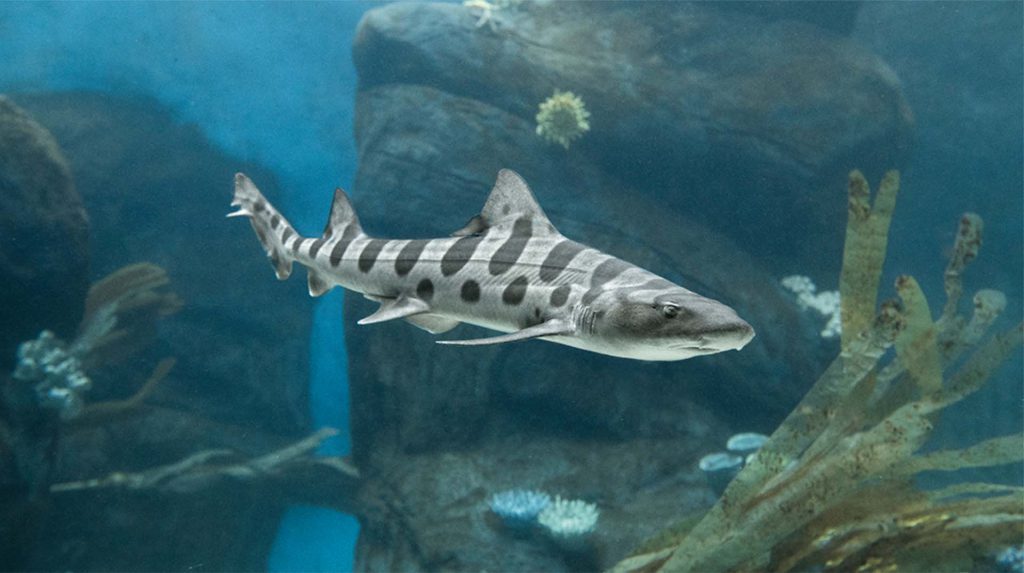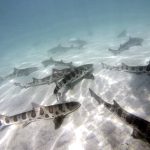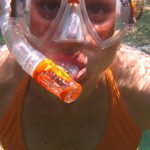Leopard Shark 101

If you’ve been to La Jolla Cove in southern California during the summer, you’ve probably heard about the leopard sharks! Swimming and snorkeling with these incredible creatures is a popular summertime activity with both locals and tourists alike. And while the word ‘shark’ may sound a little scary, leopard sharks are actually completely harmless to humans and offer a fun way to explore the underwater world off the shores of La Jolla. Here’s everything you need to know about leopard sharks!
Markings and Features
Leopard sharks (Triakis semifasciata) are a member of the Houndshark family and have quite distinctive features; including large dark spots and saddle type markings. The sharks have a broad, short snout, triangular pectoral fins, a short dorsal fin, and a notched, asymmetrical tailfin. On top they are usually a silver or bronzed-gray, fading to white underneath, with distinct dark spots and blotches on its back, sides, and pectoral fins.
They can live up to 30 years, and take more than a decade to reach maturity. They generally only grow to about four or five feet (in rare occasions they can reach up to seven feet) and the heaviest ever recorded weighed in at a whopping forty pounds.
View this post on Instagram
Habitat
The leopard shark is found in continental waters, both nearshore and offshore, and their preference is for waters that are cool to warm in temperate or sandy/muddy bays or estuaries. They love sand flats, mud flats, and rocky bottom areas near reef sites and kelp beds — which explains their love of La Jolla!
The sharks are usually found near the bottom of shallow water, and they are exceptionally strong swimmers. Oftentimes, they are joined in a school of others that include the Smooth-Hound, gray Smooth-Hound, or the Piked Dogfish.
They’ve been found all across the Eastern North Pacific, from Oregon to the Gulf of California and Mexico.
Interaction with Humans
Leopard sharks are harmless to humans. Only one attack has ever been recorded, and it happened in 1955 in Trinidad Bay, California. Fortunately, the diver was not seriously injured.
The leopard shark has recently become a protected species in California and Oregon waters so that they are not overfished. Sports anglers, spearfishers, and small-scale commercial line fisheries are typically the ones who go after the shark.
[widget id=”text-2″]
Mating Season
Female leopard sharks travel to La Jolla each summer to mate with males and spawn their young, which is why there is such a large influx of them at the beginning of summer (around June).
The female leopard becomes mature at ten to fifteen years of age and males at seven to thirteen years. During the annual breeding season, schools of these sharks move from deeper water into nearshore shallower water. Fertilization is internal. The type of reproduction is called aplacental viviparity or ovoviviparity. The fertilized eggs hatch inside the female’s body and pups are born live. After a ten to twelve-month gestation, seven to thirty-six pups about 17.8 cm (7 in) in total length are born. They are independent at birth, but usually stay in shallow bays and estuaries before venturing out into deeper ocean waters
Female leopard sharks have been observed giving birth in a variety of habitats along the California coastline from eel grass to sandbars and the open ocean.

Behavior
Leopard sharks congregate by size and sex in large nomadic schools. The schools appear and disappear within a few hours. Schools follow the tide as they feed, moving closer to shore as the tide comes in and then swimming away before it recedes. In addition to feeding, the movement may be influenced by temperature, salinity and amount of dissolved oxygen. Large schools have even been observed in the surf zone. They are also known to form schools with California round rays and with sevengill sharks, and smoothhound sharks. The latter are close relatives.
The leopard shark diet consists mostly of smaller shellfish; including clams, crabs, shrimp, squid, and fish eggs.
[ad link=”https://www.lajolla.com/article/la-jolla-snorkeling-leopard-sharks/” size=”300×250″]
Conservation Efforts
The California Department of Fish and Wildlife closely manages the leopard shark fishery within state waters. Use of gill nets in waters typically inhabited by these sharks is prohibited. The recreational fishery for leopard sharks is open year-round and coast-wide to diverse and shore-based anglers. The fishery is open to boat-based anglers year-round in designated areas only. Outside these areas, it is open seasonally between January and June.
In federal waters, leopard sharks are one of three shark species under the management authority of the National Oceanic and Atmospheric Administration (NOAA) National Marine Fisheries Service through the Pacific Coast Groundfish Fishery Management Plan (Groundfish FMP).
Currently listed internationally as Least Concern, overfishing, loss of shallow water nurseries, and pollution of these areas from runoff are threats to these sharks. They have been found to contain high levels of mercury attributed to either water quality or ingestion of food items containing mercury.
[ad size=728×90]
Snorkeling with the Leopard Sharks
The end of August and September are usually the best times to see La Jolla Leopard Sharks, as this is towards the end of the mating season and there are higher numbers of sharks. The ideal time to go is during the day, when there are calm waters and when it’s sunny (as they will be easier to spot).
La Jolla Shores, where the water is warmer and shallower, is usually where snorkelers and swimmers venture out to see and swim with the leopard sharks. It’s easier for them to search for food in the sand and kelp forests, which are protected by the La Jolla Underwater Park Preserve. Their diet consists mostly of smaller shellfish; including clams, crabs, shrimp, squid, and fish eggs.
During peak season, you can simply swim out into the water at La Jolla Shores and see the leopard sharks — they will often be that close to shore. Wade out up to your knees or hips, and you’ll see them swimming around your feet (which is quite an experience!). There’s no reason to be scared of these little guys, as they are completely harmless to humans and won’t bite or bother you.
There are a few different ways to really see the La Jolla Leopard Sharks. You can:
- Swim out by yourself at La Jolla Shores and simply watch them through the water, which is usually pretty clear.
- Snorkel the La Jolla shores to get a better look at the sharks through a snorkel mask; either with your own gear or a snorkel rental. If you don’t have your own gear, many companies will rent you gear for the entire day at one price: Everyday California and La Jolla Kayak are just a couple.
- Take a guided snorkeling tour from any number of companies located in La Jolla Shores:
- Take the guided snorkeling tours offered by the Birch Aquarium at Scripps in southern California. The tours are typically held from July through September, and these are a great option if you want to learn more about the sharks, as there is a trained naturalist guiding each tour. Intermediate swimming ability is required and previous snorkeling experience is recommended (ages 10+).
A Few Fun Facts About Leopard Sharks
- Sometimes the leopard shark is referred to as a cat shark.
- They can form large schools that contain other types of sharks.
- Leopard sharks have a tooth pattern that is called “pavement-toothed.”
- They often rest on the ocean floor and pump water over their gills.
- The genus Triakis is derived from the Greek word “triakis” meaning three-pointed, referring to its three-pointed teeth. This shark species name semifasciata refers to its “half-banded” markings.
- In the San Francisco Bay, leopard sharks and piked dogfish have been observed engaging in a unique feeding strategy: the two sharks species will swim at the surface, with mouths open, in a counter-clockwise direction. At the same time, densely packed schools of anchovies are gathered at the surface and will swim in a clockwise direction. While the sharks don’t exhibit any specific hunting behavior or directed movements toward the oncoming anchovies, the sharks’ posture and movement does result in ingestion of incidental prey (i.e. anchovies) which inadvertently swim into the open maw of the prowling sharks.
To learn more about activities and fun things to do at La Jolla Shores and La Jolla Cove, visit our guides section!






